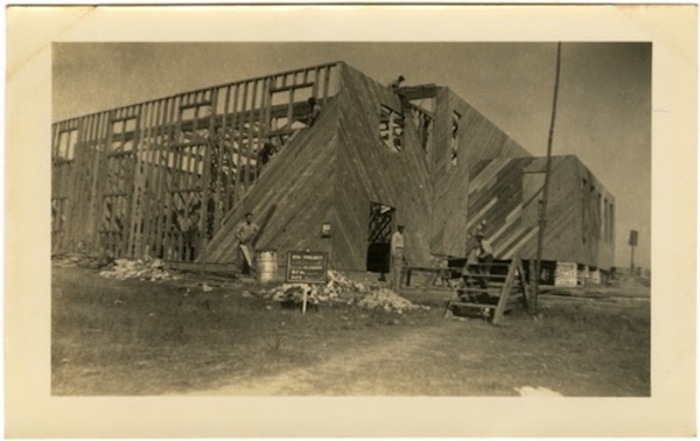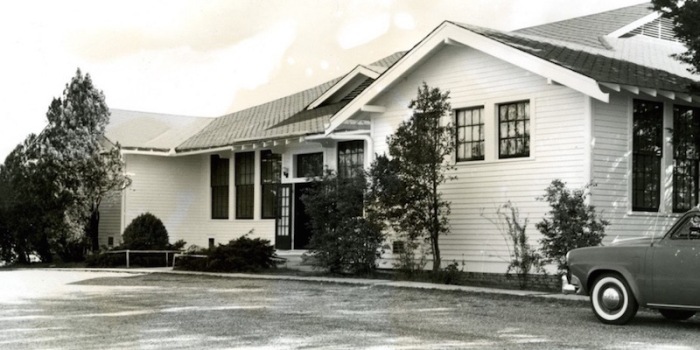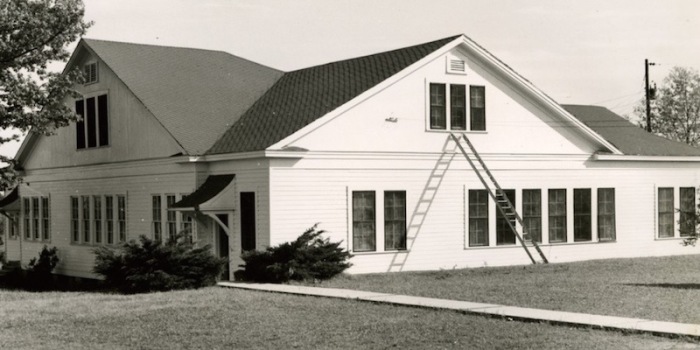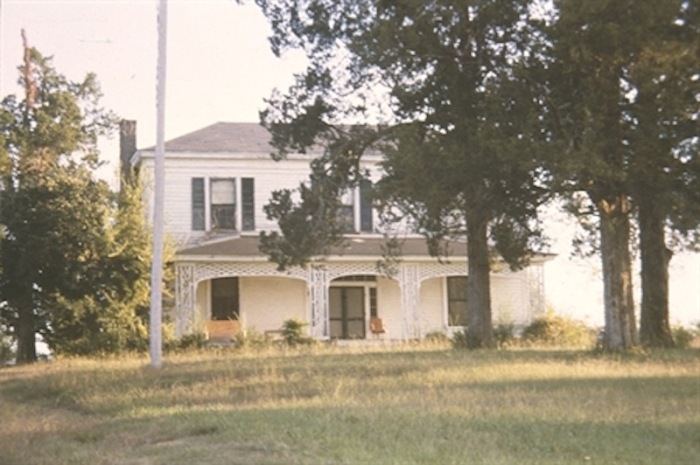In 1930, Farmhaven was a small community “about 14 miles east of Canton on the Canton-Carthage graveled highway.” In 2018, that is Old MS 16/Pat Luckett Road, slightly south of current MS 16. When I began this story, it was to chronicle the involvement of the National Youth Administration and the Public Works Administration projects in Farmhaven as a New Deal in Mississippi post. Instead, I will take a more circuitous and convoluted approach to this rural Mississippi community and its schools, leaving a lot of unanswered questions.

School Buildings of Madison County, Mississippi ADA for 1954-1955, Series 1513 School Photograph Scrapbooks, Mississippi Department of Archives and History, Digital Archives.
Mississippi Department of Archives and History, Historic Resources Inventory lists the gymnasium as constructed in 1936, but no other information is available, and I do not locate anything in the newspaper archives related to construction of the gymnasium in 1936. What I can locate about Farmhaven’s gymnasiums is that the first one was constructed in 1930.
This is one of the very few rural schools in Mississippi which is so fortunate to have a gymnasium.” (Clarion-Ledger, Jan. 8, 1930, p. 10)
Some time prior to 1935, application for “Farmhaven school” #4986 was submitted to the Federal Administration of Public Works (PWA), however, Farmhaven does not appear on the official list of PWA projects completed in Mississippi. The Clarion-Ledger carried two items in February 1936 indicating work on the Farmhaven “school project” had been approved and ordered to begin “if the required amount of labor is available” (Feb. 3, p. 3; Feb. 8, p. 9). The reference to labor does support that it was some type of improvement project and would employ local workforce.

From ìW.P. 5294, Application #872: Farmhaven Cons. School Gymnasium, Madison County. Project involved demolition of existing gym and salvage of lumber.î ìNYA. I-B1-45î. Sysid 74305. Scanned as TIFF in 2010/09/23 by MDAH. Credit: Courtesy of the Mississippi Department of Archives and History.
The National Youth Administration scrapbook (MDAH Digital Archives Series 2018) contains photographs for the years 1937-1939, and documents the demolition of the existing Farmhaven gymnasium (presumably the 1930 building). Other photographs point to the construction of the gym pictured at the top of this post.
The Farmhaven Gymnasium project employed 30 youths for three months at a cost of $1,080 (Welfare report for year given, Clarion-Ledger, Feb. 2, 1940, p. 3).
MDAH/HRI identified the Administration Building for the white school complex, located on the South side of Pat Luckett Road, as constructed c. 1924, 1-story, demolished. I found no other information about this building in the newspaper archives. Prior to 1930, news items related to sports events and other extracurricular activities, and a 1926 accident in which a boy fell under the wheels of a school truck, resulting in breaking both legs between the knee and hip. The high school building for black students was located on the North side of Pat Luckett Road, constructed 1928, and was a 1-story building, also demolished.

Farmhaven High School, Series 1513 School Photograph Scrapbooks, MDAH Digital Archives
Farmhaven Considated High School was authorized to borrow $2000 by Mississippi HB 716, introduced by Representative Lane in 1930.
The Farmhaven High School “after 33 years of service to the children of the eastern part of the county, is going off the scholastic and community center scene in a blaze of activity…” as beginning 1958, students would attend Canton High School (After 33 good years: Homecoming to mark farewell to Farmhaven, Apr. 14, 1957, Clarion-Ledger, p. 12).

Farmhaven Vocational Building, Series 1513 School Photograph Scrapbooks, MDAH Digital Archives
The vocational building [white] was a 1.5 story building, constructed 1936 according to MDAH Historic Resources Inventory. This building was demolished. The school at Farmhaven closed in 1957 and the shop equipment was move to Madison-Ridgland school (Clarion-Ledger, Aug. 28, 1960, p. 10). The Farmhaven building continued in use as an adult classroom for area farmers.
The vocational teacher’s home was constructed by the National Youth Administration with supervision from NYA supervisor Carl R. Furr (Clarion-Ledger, Farmhaven NYA ends project, Nov. 19, 1937, p. 17).
None of the boys working on the project had any previous experience in carpentering when the project was started in September. However, the completed home is drawing many complements to the school and the group which did so much for its construction.
Both the white school and black schools had teacher’s houses. Construction date for the white teacher’s house was 1925, so the photo on the right above is possibly that house. All teachers’ houses in the Farmhaven community have been demolished.

Farmhaven [White] School Complex, MDAH Historic Resources Inventory
Categories: Lost Mississippi, New Deal, Schools






I like the house in the final photograph. Its porch is what architectural historian Robert Gamble would label Cottage Orné style, even if the rest of the house is vernacular Greek Revival.
LikeLike
I wonder if it might have been the superintendent’s house?
LikeLike
It is possibly a miss IDed photo.
LikeLike
i agree with mr white on his stylistic comments, and, to me the house . looks 1850s. similar porches appear throughout the united states at this time–yes, there are even some in my upstate ny village! they might be called the ‘ancestors’ of the eastlake and queen anne style porches that are called ‘gingerbread’ nowadays.
architectural ‘creations’ such as these weren’t difficult to fabricate and added something ‘fancy’ to an otherwise plain structure. gamble’s ‘cottage orne'(ornamented cottage) term is probably not what the american clients or builders would have said, and, in general, this kind of woodwork seems to fall into the italianate style, although some of it has a bit of gothic revival.
and, yes, i have seen ostensibly greek revival columns or pilasters ‘cut through’ with this kind of fanciness, so, all in all, these porches were a typical mid-19th century stylistic mix.
i believe that gamble took his term from descriptions in english pattern books of a bit earlier in the 19th century..
–
i couldn’t tell from the text, but is the last house standing? and, might it be the plantation house already on the site when the 20th century complex was constructed?
LikeLike
Possibly. Google map shows a 2 story house that might be it (443 Pat Luckett Rd.), but the porch appears to have been altered. It is not fully identifiable due to foliage and poor image quality.
LikeLike